Exploring the Structural and Electronic Properties of Niobium Carbide Clusters: A Density Functional Theory Study
Abstract
1. Introduction
2. Results and Discussion
2.1. Geometry
2.1.1. Nb5Cn (n = 1–7)
2.1.2. Nb6Cn (n = 1–7)
2.2. Comparison between Calculated and Experimental Vertical Ionization Potential
2.3. Relative Stability
2.4. Stability Analysis via AIMD Simulations
2.5. Density of States
3. Computational Methods
4. Conclusions
Supplementary Materials
Author Contributions
Funding
Institutional Review Board Statement
Informed Consent Statement
Data Availability Statement
Acknowledgments
Conflicts of Interest
References
- Alonso, J.A. Electronic and atomic structure, and magnetism of transition-metal clusters. Chem. Rev. 2000, 100, 637–678. [Google Scholar] [CrossRef] [PubMed]
- Knickelvein, M.B. Experimental observation of superparamagnetism in manganese clusters. Phys. Rev. Lett. 2001, 86, 5255–5257. [Google Scholar] [CrossRef] [PubMed]
- Xu, X.S.; Yin, S.Y.; Moro, R.; De Heer, W.A. Magnetic moments and adiabatic magnetization of free cobalt clusters. Phys. Rev. Lett. 2005, 95, 237209. [Google Scholar] [CrossRef] [PubMed]
- Fan, Y.W.; Kong, X.Y.; Zhao, L.J.; Wang, H.Q.; Li, H.F.; Zhan, Q.; Xie, B.; Xu, H.G.; Zheng, W.J. A joint experimental and theoretical study on structural, electronic, and magnetic properties of MnGen− (n = 3–14) clusters. J. Chem. Phys. 2021, 154, 204302. [Google Scholar] [CrossRef] [PubMed]
- Brock, L.; Duncan, M.A. Near-threshold photoionization to probe neutral “met-car” clusters. J. Phys. Chem. 1996, 100, 5654–5659. [Google Scholar] [CrossRef]
- Loh, S.K.; Lian, L.; Armentrout, P.B. Oxidation reactions at variably sized transition metal centers: Fen+ and Nbn+ + O2 (n = 1–3). J. Chem. Phys. 1989, 91, 6148–6163. [Google Scholar] [CrossRef]
- Hales, D.A.; Lian, L.; Armentrout, P.B. Collision-induced dissociation of Nbn+ (n = 2–11): Bond energies and dissociation pathways. Int. J. Mass Spectrom. Ion Process. 1990, 102, 269–301. [Google Scholar] [CrossRef]
- Cartier, S.F.; May, B.D.; Castleman, A.W., Jr. The delayed ionization and atomic ion emission of binary metal metallocarbohedrenes TixMyC12 (M = Zr, Nb; 0 ≤ y ≤ 4; x + y = 8). J. Chem. Phys. 1996, 104, 3423–3432. [Google Scholar] [CrossRef]
- Deng, H.T.; Guo, B.C.; Kerns, K.P.; Castleman, A.W., Jr. Gas phase reactions of the met-cars Ti8C12+, Nb8C12+ and Ti7Nb12+ with acetone and methyl lodide. J. Phys. Chem. 1994, 98, 13373–13378. [Google Scholar] [CrossRef]
- Yeh, C.S.; Byun, Y.G.; Afzaal, S.; Kan, S.Z.; Lee, S.; Freiser, B.S.; Hay, P.J. Experimental and theoretical studies on Nb4C40/+: Reactivity and structure of the smallest cubic niobium-carbon cluster. J. Am. Chem. Soc. 1995, 117, 4042–4048. [Google Scholar] [CrossRef]
- Byun, Y.G.; Lee, S.A.; Kan, S.Z.; Freiser, B.S. Reactivities of metallocarbohedrenes: Nb8C12+. J. Phys. Chem. 1996, 100, 14281–14288. [Google Scholar] [CrossRef]
- Yang, D.S.; Zgierski, M.Z.; Berces, A.; Hackett, P.A.; Roy, P.N.; Martinez, A.; Carrington, T.; Salahub, D.R.; Fournier, R.; Pang, T.; et al. Vibrational and geometric structures of Nb3C2 and Nb3C2+ from pulsed field ionization-zero electron kinetic energy photoelectron spectra and density functional calculations. J. Chem. Phys. 1996, 105, 10663–10671. [Google Scholar] [CrossRef]
- Li, S.; Wu, H.; Wang, L. Probing the electronic structure of metallocarbohedrenes: M8C12 (M = Ti, V, Cr, Zr, Nb). J. Am. Chem. Soc. 1997, 119, 7417–7422. [Google Scholar] [CrossRef]
- Knappenberger, K.L., Jr.; Clayborne, P.A.; Reveles, J.U.; Sobhy, M.A.; Jones, C.E.; Gupta, U.U.; Khanna, S.N.; Iordanov, I.; Sofo, J.; Castleman, A.W., Jr. Anion photoelectron spectroscopy and density functional investigation of diniobium-carbon clusters. ACS Nano 2007, 1, 319–326. [Google Scholar] [CrossRef] [PubMed]
- Geusic, M.E.; Morse, M.D.; Smalley, R.E. Hydrogen chemisorption on transition metal clusters. J. Chem. Phys. 1985, 82, 590–591. [Google Scholar] [CrossRef]
- Whetten, R.L.; Zakin, M.R.; Cox, D.M.; Trevor, D.J.; Kaldor, A. Electron binding and chemical inertness of specific Nbx clusters. J. Chem. Phys. 1986, 85, 1697–1698. [Google Scholar] [CrossRef]
- Eduok, U. Niobia Nanofiber-Reinforced Protective Niobium Oxide/Acrylate Nanocomposite Coatings. ACS Omega 2020, 5, 30716–30728. [Google Scholar] [CrossRef] [PubMed]
- Korzyński, M.D.; Xie, L.S.; Dincă, M. Structural Characterization of a High-Nuclearity Niobium(V) Carboxylate Cluster Based on Pivalic Acid. Helv. Chim. Acta 2020, 103, e2000186. [Google Scholar] [CrossRef]
- Wang, H.Q.; Li, H.F. Probing the structural and electronic properties of al-doped small niobium clusters. Chem. Phys. Lett. 2012, 554, 231–235. [Google Scholar] [CrossRef]
- Grönbeck, H.; Rosén, A.; Andreoni, W. Structural electronic, and vibrational properties of neutral and charged Nbn (n = 8, 9, 10) clusters. Phys. Rev. A 1998, 58, 4630–4636. [Google Scholar] [CrossRef]
- Pansinia, F.N.N.; Camposb, M.D.; Netoa, A.C.; Sergiob, C.S. Theoretical study of the electronic structure and electrical properties of Al-doped niobium clusters. Chem. Phys. 2020, 535, 110778. [Google Scholar] [CrossRef]
- Prudnikava, A.; Tamashevich, Y.; Babenkov, S.; Makarova, A.; Smirnov, D.; Aristov, V.; Molodtsova, O.; Kugeler, O.; Viefhaus, J.; Foster, B. Systematic study of niobium thermal treatments for superconducting radio frequency cavities employing x-ray photoelectron spectroscopy. Supercond. Sci. Technol. 2022, 35, 065019. [Google Scholar] [CrossRef]
- Oliveira, L.; Pereira, M.; Heitman, A.P.; Filho, J.; Olivira, C.; Ziolek, M. Niobium: The focus on catalytic application in the conversion of biomass and biomass derivatives. Molecules 2023, 28, 1527. [Google Scholar] [CrossRef]
- Luo, P.; Zhao, Y.H. Niobium nitride preparation for superconducting single-photon detectors. Molecules 2023, 28, 6200. [Google Scholar] [CrossRef] [PubMed]
- Wei, S.; Guo, B.C.; Deng, H.T.; Kerns, K.; Purnell, J.; Buzza, S.A.; Castleman, A.W., Jr. Formation of met-cars and face-centered cubic structures: Thermodynamically or kinetically controlled? J. Am. Chem. Soc. 1994, 116, 4475–4476. [Google Scholar] [CrossRef]
- Pilgrim, J.S.; Brock, L.R.; Duncan, M.A. Photodissociation of niobium-carbon clusters and nanocrystals. J. Phys. Chem. 1995, 99, 544–550. [Google Scholar] [CrossRef]
- Dryza, V.; Addicoat, M.A.; Gascooke, J.R.; Buntine, M.A.; Metha, G.F. Threshold photoionization and density functional theory studies of the niobium carbide clusters Nb3Cn (n = 1–4) and Nb4Cn (n = 1–6). J. Phys. Chem. A 2008, 112, 5582–5592. [Google Scholar] [CrossRef] [PubMed]
- Fukushima, N.; Miyajima, K.; Mafune, F. Ionization energies of niobium carbide clusters NbnCm (n = 3–10, m = 0–7). J. Phys. Chem. A 2009, 113, 2309–2315. [Google Scholar] [CrossRef]
- Gusev, A.I. Anisotropy of microstructure and elastic properties of niobium carbide nanopowders. Solid State Sci. 2020, 100, 106092. [Google Scholar] [CrossRef]
- Chebanenko, M.I.; Danilovich, D.P.; Lobinsky, A.A.; Popkov, V.I.; Rempel, A.A.; Valeeva, A.A. Novel high stable electrocatalyst based on non-stoichiometric nanocrystalline niobium carbide toward effective hydrogen evolution. Int. J. Hydrogen Energy 2021, 46, 16907–16916. [Google Scholar] [CrossRef]
- Zhai, H.J.; Liu, S.R.; Wang, L.S. Photoelectron spectroscopy of mono-niobium carbide clusters NbCn− (n= 2–7): Evidence for a cyclic to linear structural transition. J. Chem. Phys. 2001, 115, 5170–5178. [Google Scholar] [CrossRef]
- Il’in, E.G.; Parshakov, A.S.; Teterin, Y.A.; Maslakov, K.I.; Teterin, A.Y. Surface morphology and composition of a NbC/C composite studied by scanning electron microscopy and X-ray photoelectron spectroscopy. Inorg. Mater. 2020, 56, 443–450. [Google Scholar] [CrossRef]
- Hamrick, Y.M.; Weltner, W., Jr. Quenching of angular momentum in the ground states of VC, NbC, VSi, and NbSi molecules. J. Chem. Phys. 1991, 94, 3371–3380. [Google Scholar] [CrossRef]
- Valeeva, A.A.; Gusev, A.I. Effect of nonstoichiometry on elastic properties of niobium carbide NbCy. Int. J. Refract. Met. H. 2021, 95, 105435. [Google Scholar] [CrossRef]
- Li, H.F.; Wang, H.Q.; Zhang, J.M.; Qin, L.X.; Zheng, H.; Zhang, Y.H. Investigation of structures, stabilities, and electronic and magnetic properties of niobium carbon clusters Nb7Cn (n = 1–7). Molecules 2024, 29, 1692. [Google Scholar] [CrossRef] [PubMed]
- Frisch, M.J.; Trucks, G.W.; Schlegel, H.B.; Scuseria, G.E.; Robb, M.A.; Cheeseman, J.R.; Scalmani, G.; Barone, V.; Mennucci, B.; Petersson, G.A.; et al. Gaussian 09, Revision C.01; Gaussian Inc.: Wallingford, CT, USA, 2010. [Google Scholar]
- Diego, I.; Alejandro, V.S.; Luis, L.P.; Williams, G.A.; Maria, L.C.; Osvaldo, Y.; William, T. Revisiting the potential-energy surface of CnBe3n+2H2n+22+ (n = 2–4) clusters: Are planar pentacoordinate carbon structures the global minima? Phys. Chem. Chem. Phys. 2023, 25, 20235–20240. [Google Scholar]
- Venkatesan, S.T.; Aland, S.; Diego, I.; Pothiappan, V.; Krishnan, T.; Saikat, R.; Anakuthil, A.; William, T. Why an integrated approach between search algorithms and chemical intuition is necessary? Phys. Chem. Chem. Phys. 2022, 24, 11680–11686. [Google Scholar]
- Osvaldo, Y.; Diego, I.; Brandon, U.A.; Alejandro, V.E.; Ricardo, P.R.; Mauricio, T.S.; Jorge, G.; Jorge, B.; Gabriel, M.; William, T. Evaluation of restricted probabilistic cellular automata on the exploration of the potential energy surface of Be6B11−. Theor. Chem. Acc. 2020, 139, 41. [Google Scholar]
- Roy, D.; Corminboeuf, C.; Wannere, C.S.; King, R.B.; Schleyer, P.V.R. Planar tetracoordinate carbon atoms centered in bare four-membered rings of late transition metals. Inorg. Chem. 2006, 45, 8902–8906. [Google Scholar] [CrossRef]
- Bera, P.P.; Sattelmeyer, K.W.; Saunders, M.; Schaefer, H.F.; Schleyer, P.R. Mindless chemistry. J. Phys. Chem. A 2006, 110, 4287–4290. [Google Scholar] [CrossRef]
- Saunders, M. Stochastic search for isomers on a quantum mechanical surface. J. Comput. Chem. 2004, 25, 621–626. [Google Scholar] [CrossRef] [PubMed]
- Li, H.F.; Wang, H.Q. Stabilization of golden cages by encapsulation of a single transition metal atom. R. Soc. Open Sci. 2018, 5, 171019. [Google Scholar] [CrossRef] [PubMed]
- Becke, A.D. Density-functional exchange-energy approximation with correct asymptotic behavior. Phys. Rev. A 1988, 38, 3098–3100. [Google Scholar] [CrossRef]
- Perdew, J.P.; Wang, Y. Accurate and simple analytic representation of the electron-gas correlation energy. Phys. Rev. B 1992, 45, 13244–13249. [Google Scholar] [CrossRef]
- Huang, B.B.; Zhang, H.Y.; Gan, W.; Yang, M.Z.; Luo, Z.X.; Yao, J.N. Nb12+—Niobespherene: A full-metal hollow-cage cluster with superatomic stability and resistance to CO attack. Natl. Sci. Rev. 2023, 10, nwac197. [Google Scholar] [CrossRef] [PubMed]
- Pham, V.N.; Vu, T.N.; Truong, B.T.; Minh, T.N. Electronic Structures, Vibrational and Thermochemical Properties of Neutral and Charged Niobium Clusters Nbn, n = 7–12. J. Phys. Chem. A 2011, 115, 3523–3535. [Google Scholar]
- Pham, V.N.; Vu, T.N.; Minh, T.N. A New Look at the Structure and Vibrational Spectra of Small Niobium Clusters and Their Ions. J. Phys. Chem. C 2010, 114, 13210–13218. [Google Scholar]
- Neese, F. Software update: The ORCA program system-Version 5.0. Wiley Isnterdiscip. Rev. Comput. Mol. Sci. 2022, 12, e1606. [Google Scholar] [CrossRef]
- Humphrey, W.; Dalke, A.; Schulten, K. VMD: Visual molecular dynamics. J. Mol. Graph. 1996, 14, 33–38. [Google Scholar] [CrossRef]
- Lu, T.; Chen, F.W. Multiwfn: A multifunctional wavefunction analyzer. J. Comput. Chem. 2012, 33, 580–592. [Google Scholar] [CrossRef]
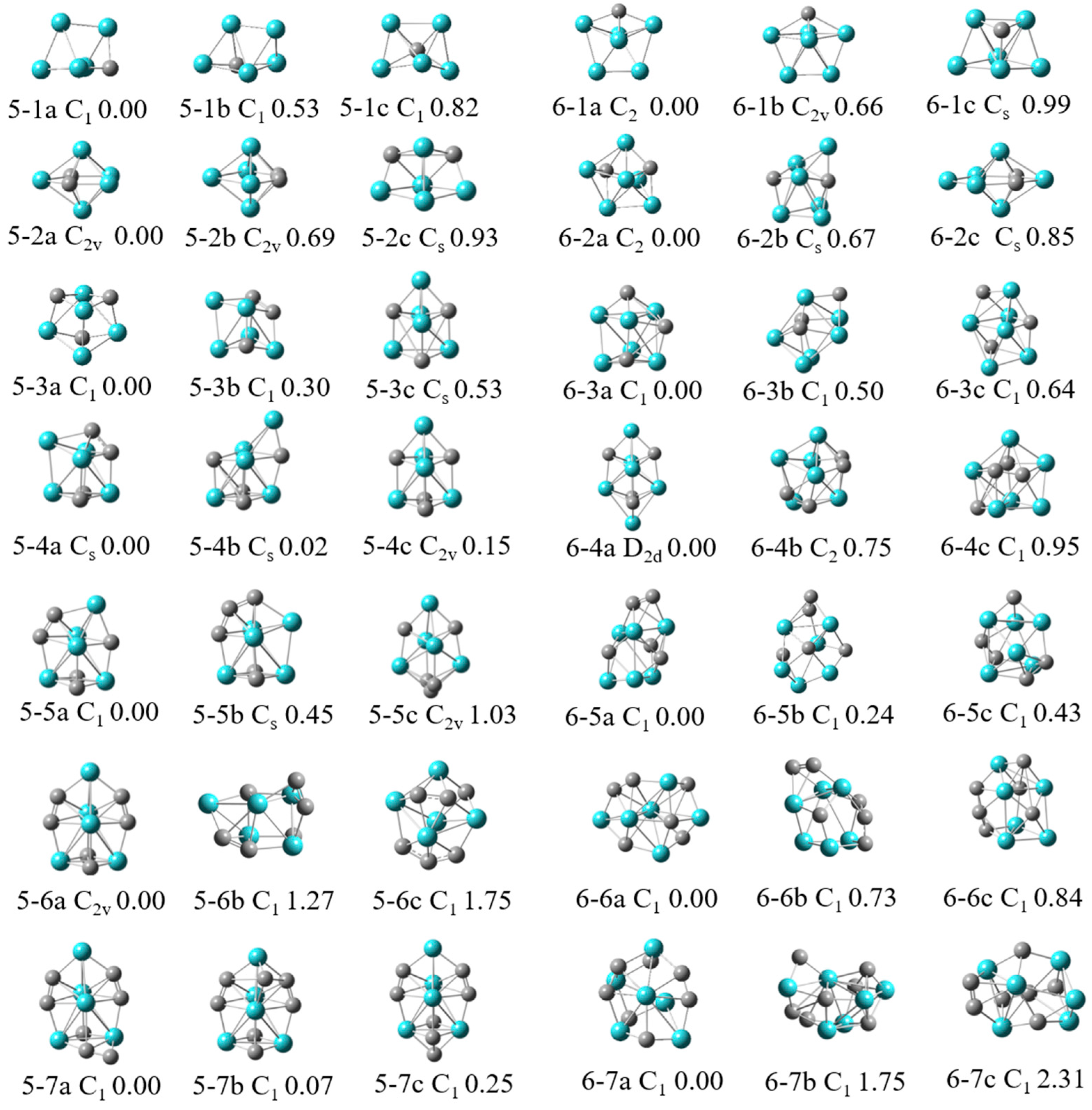

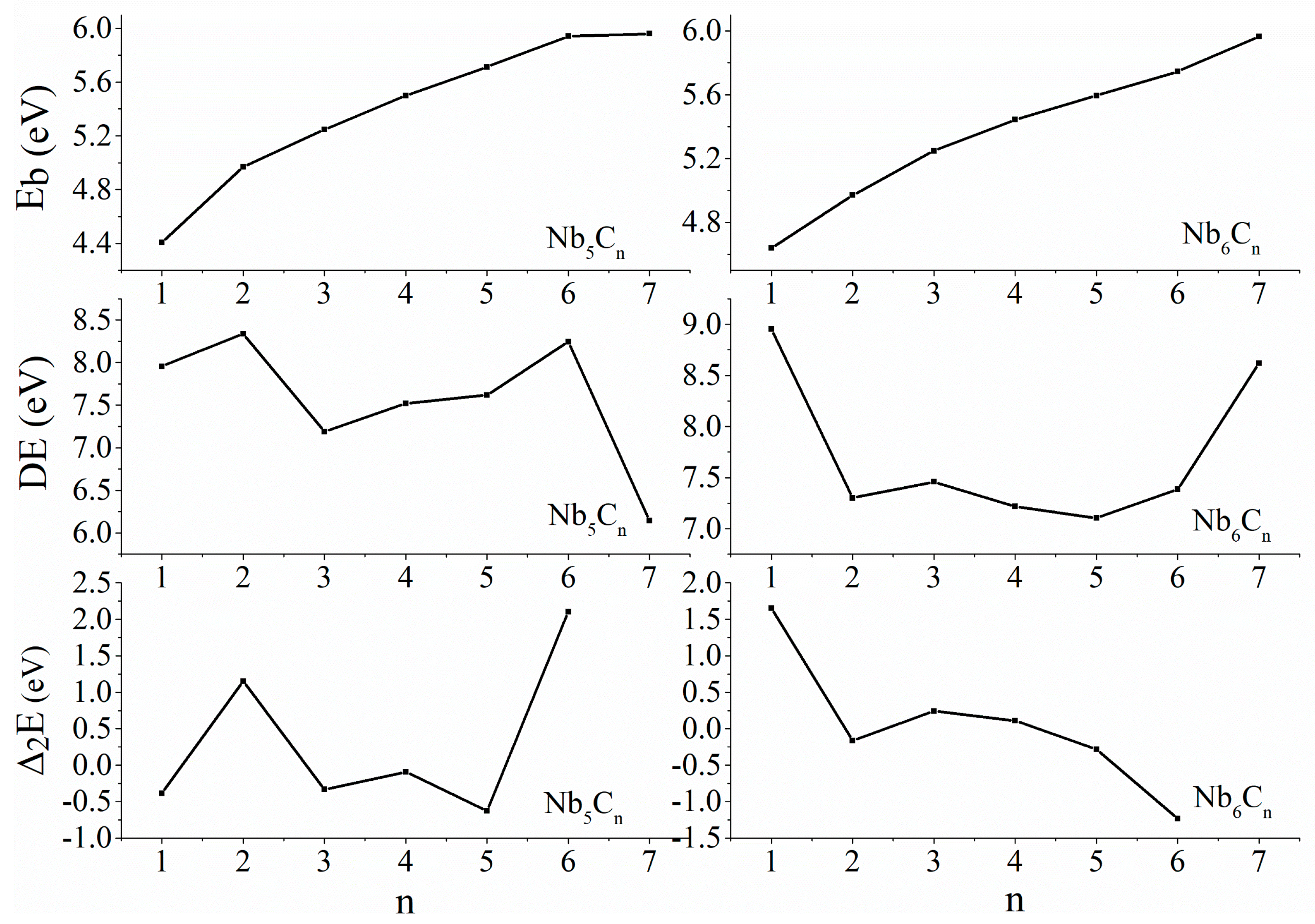
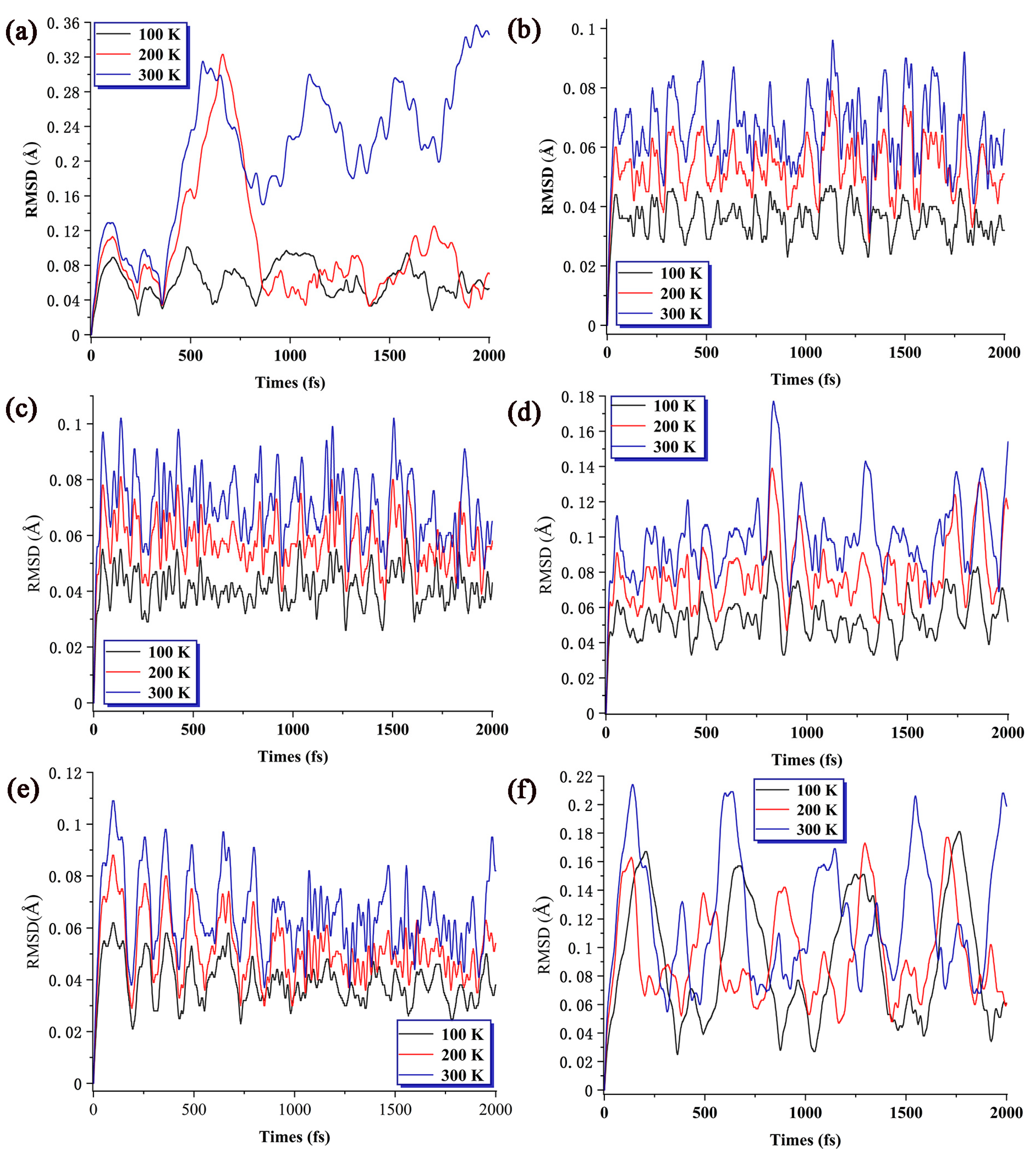
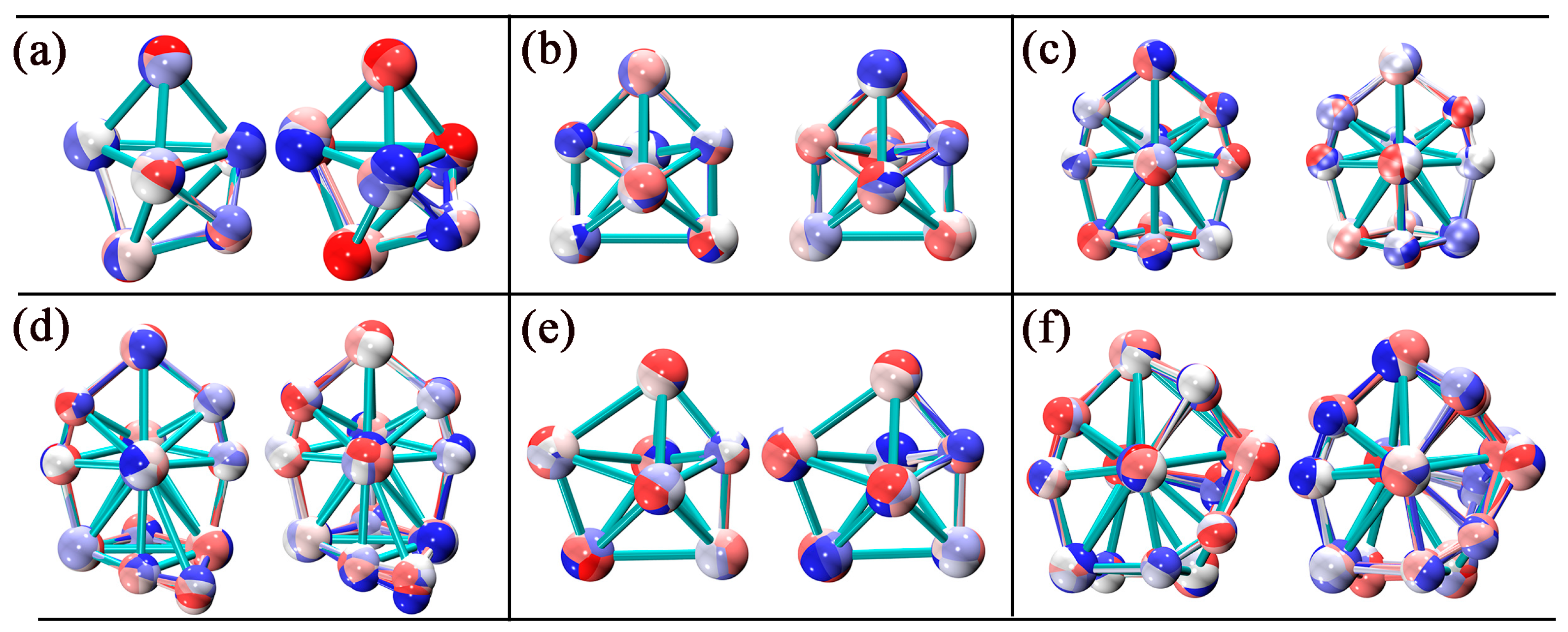
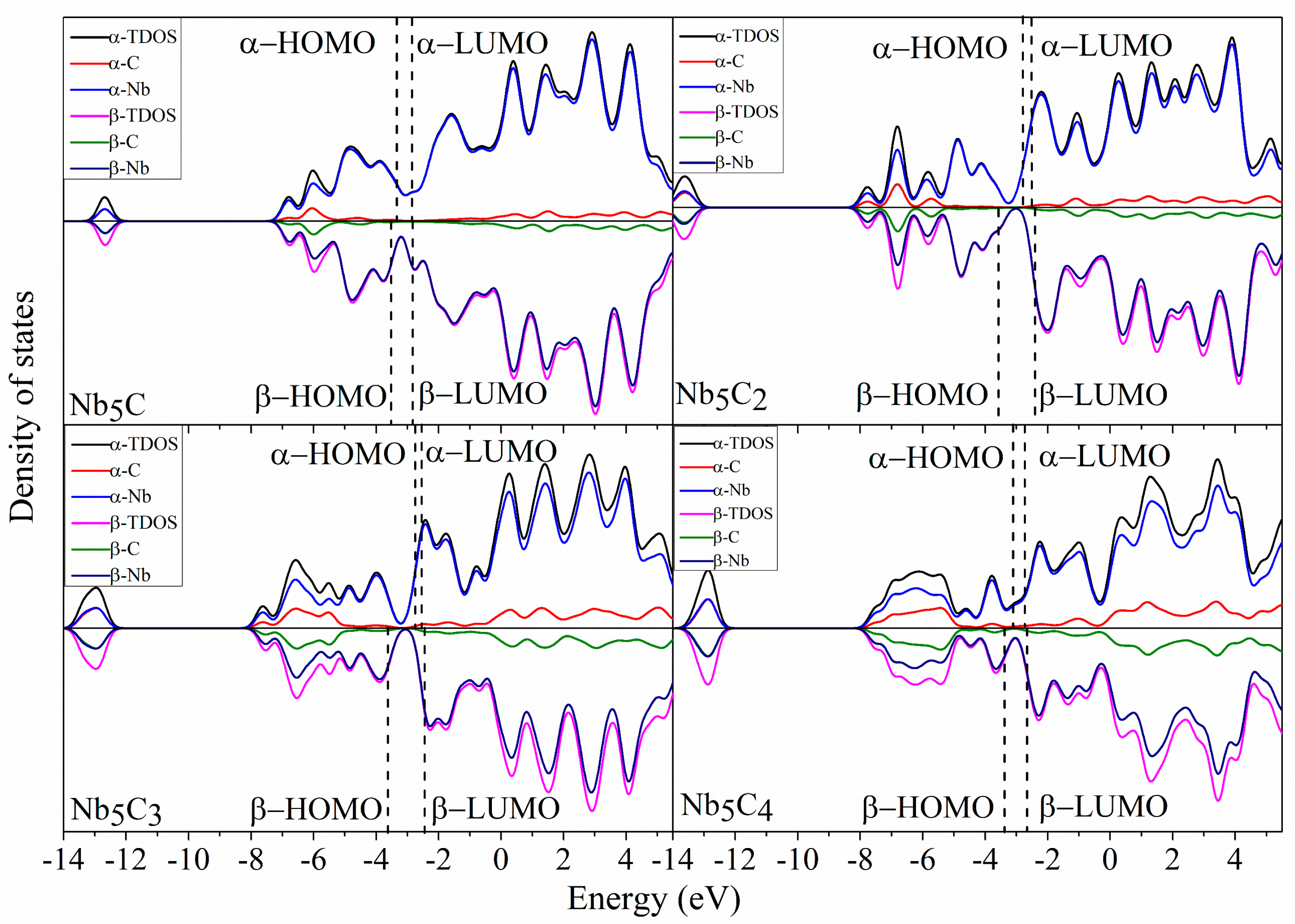
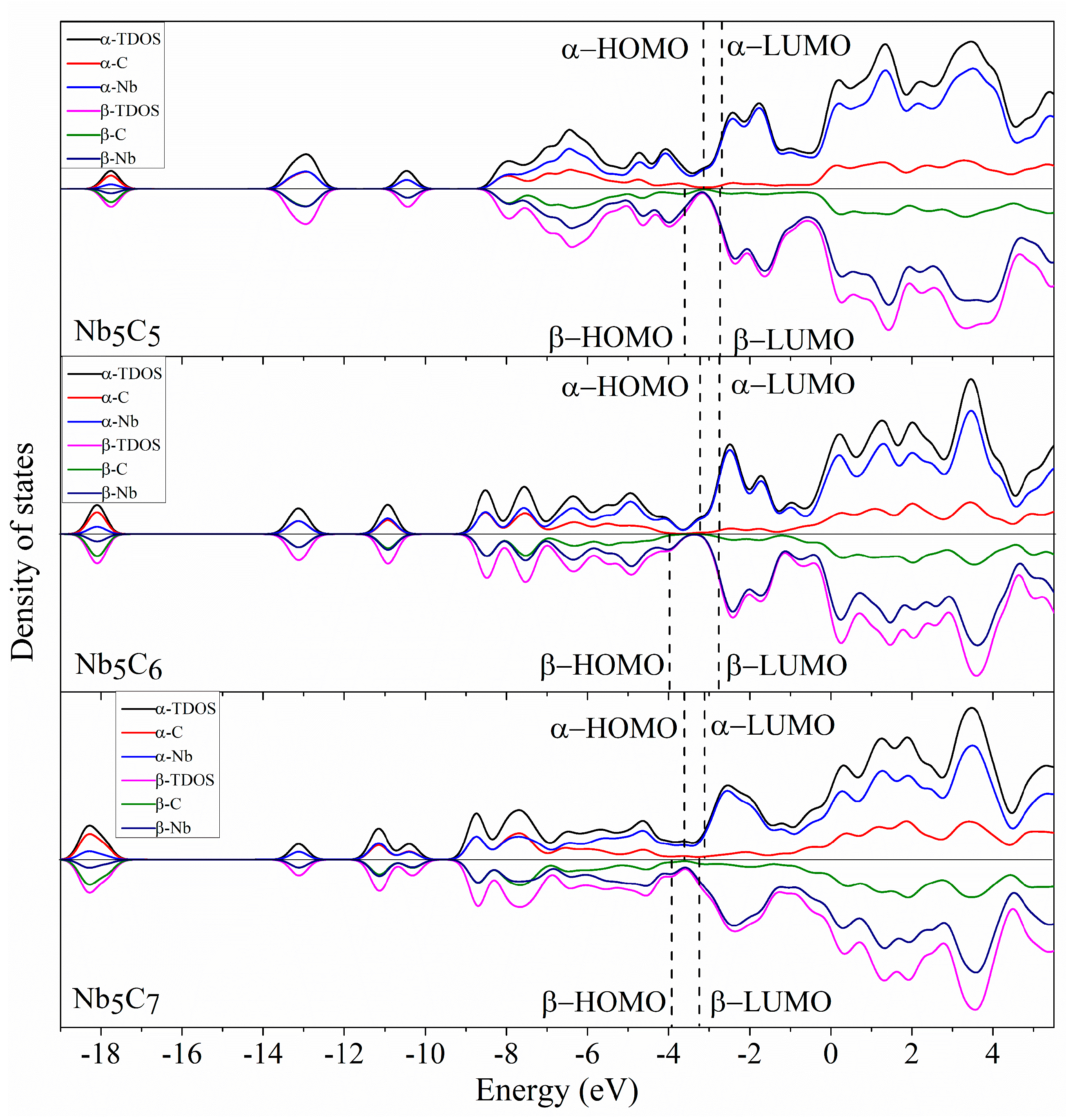

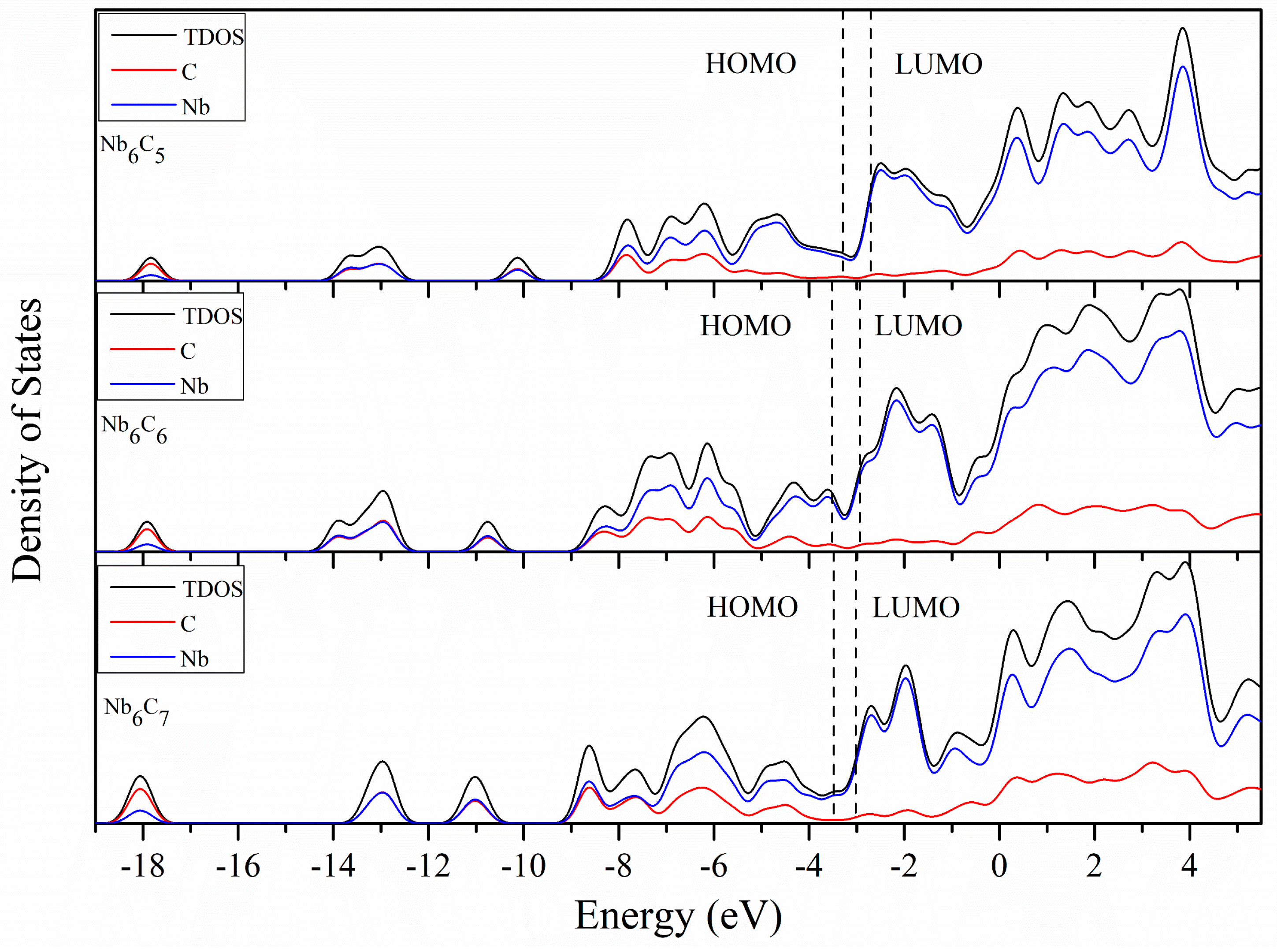
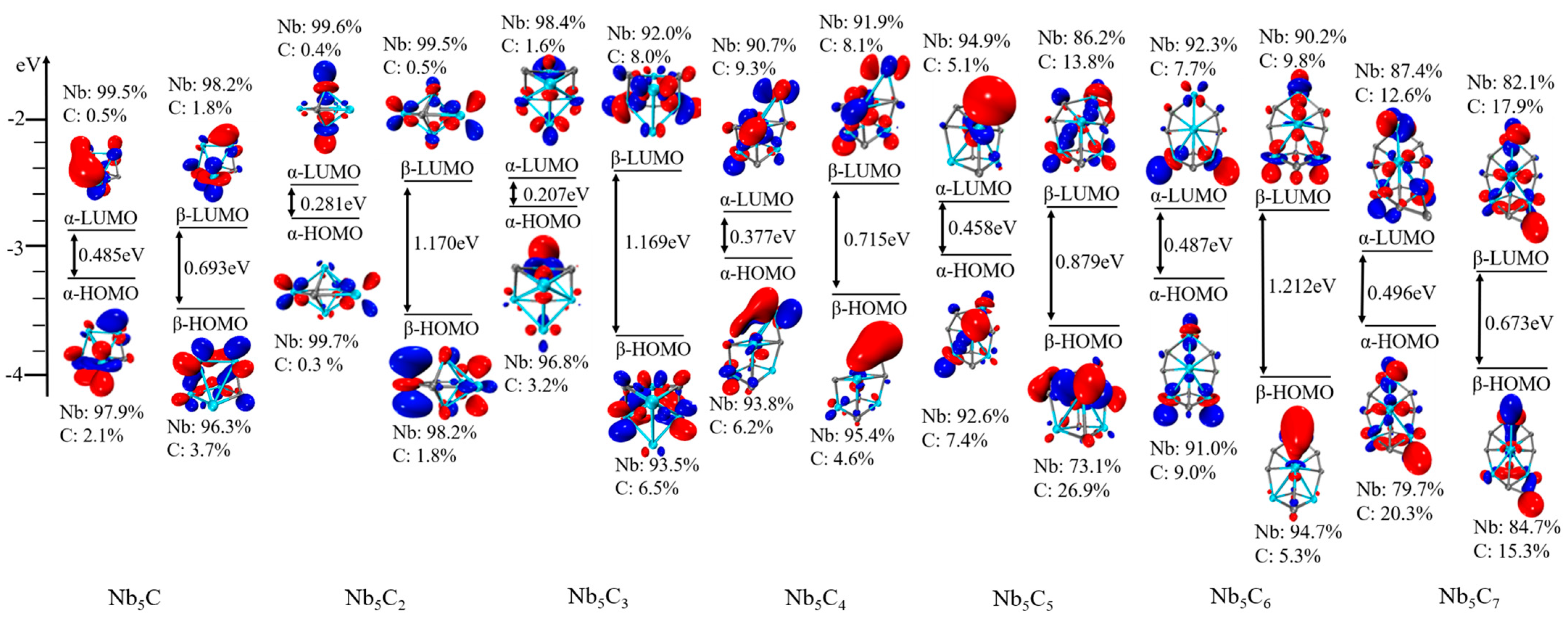
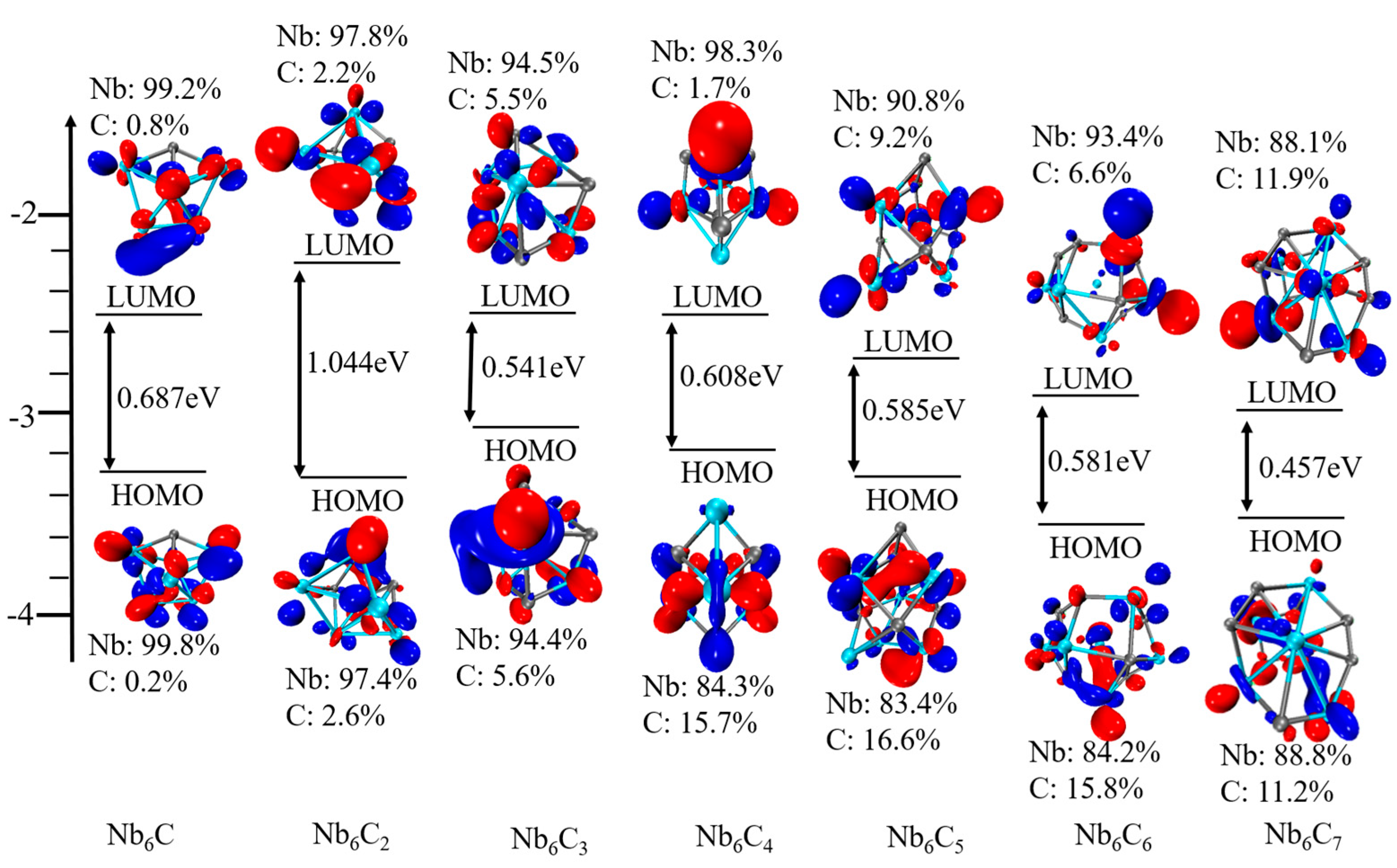
| Isomers | VIP | Expt. [28] | Isomers | VIP | Expt. [28] |
|---|---|---|---|---|---|
| 5-1a | 5.30 (1.0%) | 5.25 ± 0.08 | 6-1a | 5.11 (2.7%) | 5.25 ± 0.07 |
| 5-2a | 4.45 (3.3%) | 4.6 ± 0.15 | 6-2a | 5.20 (0.2%) | 5.21 ± 0.07 |
| 5-3a | 4.60 (1.5%) | 4.53 ± 0.05 | 6-3a | 4.99 (3.5%) | 4.82 ± 0.06 |
| 5-4b | 5.13 (0.2%) | 5.12 ± 0.12 | 6-4a | 4.94 (0.8%) | 4.9 ± 0.1 |
| 5-5a | 5.02 (0.6%) | 5.05 ± 0.10 | 6-5a | 5.18 (1.6%) | 5.1 ± 0.1 |
| 5-6a | 5.00 (0.4%) | 5.02 ± 0.08 | 6-6a | 5.28 (2.5%) | 5.15 ± 0.12 |
| 5-7a | 5.54 (8.6%) | 5.10 ± 0.12 | 6-7a | 5.28 (3.5%) | 5.1 ± 0.12 |
| Isomers | Eb | DE | Δ2E | Isomers | Eb | DE | Δ2E |
|---|---|---|---|---|---|---|---|
| 5-1a | 4.408 | 7.956 | −0.384 | 6-1a | 4.639 | 8.952 | 1.652 |
| 5-2a | 4.970 | 8.340 | 1.151 | 6-2a | 4.971 | 7.300 | −0.160 |
| 5-3a | 5.247 | 7.190 | −0.333 | 6-3a | 5.248 | 7.459 | 0.243 |
| 5-4b | 5.500 | 7.523 | −0.094 | 6-4a | 5.444 | 7.216 | 0.111 |
| 5-5a | 5.712 | 7.617 | −0.628 | 6-5a | 5.595 | 7.105 | −0.279 |
| 5-6a | 5.942 | 8.245 | 2.103 | 6-6a | 5.745 | 7.384 | −1.232 |
| 5-7a | 5.959 | 6.142 | 6-7a | 5.965 | 8.617 |
| Isomer | Atom | α | β | Isomer | Atom | HOMO | LUMO | ||
|---|---|---|---|---|---|---|---|---|---|
| HOMO | LUMO | HOMO | LUMO | ||||||
| 5-1a | Nb | 97.9% | 99.5% | 96.3% | 98.2% | 6-1a | Nb | 99.8% | 99.2% |
| C | 2.1% | 0.5% | 3.7% | 1.8% | C | 0.2% | 0.8% | ||
| 5-2a | Nb | 99.7% | 99.6% | 98.2% | 99.5% | 6-2a | Nb | 97.4% | 97.8% |
| C | 0.3% | 0.4% | 1.8% | 0.5% | C | 2.6% | 2.2% | ||
| 5-3a | Nb | 96.8% | 98.4% | 93.5% | 92.0% | 6-3a | Nb | 94.4% | 94.5% |
| C | 3.2% | 1.6% | 6.5% | 8.0% | C | 5.6% | 5.5% | ||
| 5-4b | Nb | 93.8% | 90.7% | 95.4% | 91.9% | 6-4a | Nb | 84.3% | 98.3% |
| C | 6.2% | 9.3% | 4.6% | 8.1% | C | 15.7% | 1.7% | ||
| 5-5a | Nb | 92.6% | 94.9% | 73.1% | 86.2% | 6-5a | Nb | 83.4% | 90.8% |
| C | 7.4% | 5.1% | 26.9% | 13.8% | C | 16.6% | 9.2% | ||
| 5-6a | Nb | 91.0% | 92.3% | 94.7% | 90.2% | 6-6a | Nb | 84.2% | 93.4% |
| C | 9.0% | 7.7% | 5.3% | 9.8% | C | 15.8% | 6.6% | ||
| 5-7a | Nb | 79.7% | 87.4% | 84.7% | 82.1% | 6-7a | Nb | 88.8% | 88.1% |
| C | 20.3% | 12.6% | 15.3% | 17.9% | C | 11.2% | 11.9% | ||
Disclaimer/Publisher’s Note: The statements, opinions and data contained in all publications are solely those of the individual author(s) and contributor(s) and not of MDPI and/or the editor(s). MDPI and/or the editor(s) disclaim responsibility for any injury to people or property resulting from any ideas, methods, instructions or products referred to in the content. |
© 2024 by the authors. Licensee MDPI, Basel, Switzerland. This article is an open access article distributed under the terms and conditions of the Creative Commons Attribution (CC BY) license (https://creativecommons.org/licenses/by/4.0/).
Share and Cite
Li, H.-F.; Wang, H.-Q.; Zhang, Y.-K. Exploring the Structural and Electronic Properties of Niobium Carbide Clusters: A Density Functional Theory Study. Molecules 2024, 29, 3238. https://doi.org/10.3390/molecules29133238
Li H-F, Wang H-Q, Zhang Y-K. Exploring the Structural and Electronic Properties of Niobium Carbide Clusters: A Density Functional Theory Study. Molecules. 2024; 29(13):3238. https://doi.org/10.3390/molecules29133238
Chicago/Turabian StyleLi, Hui-Fang, Huai-Qian Wang, and Yu-Kun Zhang. 2024. "Exploring the Structural and Electronic Properties of Niobium Carbide Clusters: A Density Functional Theory Study" Molecules 29, no. 13: 3238. https://doi.org/10.3390/molecules29133238
APA StyleLi, H.-F., Wang, H.-Q., & Zhang, Y.-K. (2024). Exploring the Structural and Electronic Properties of Niobium Carbide Clusters: A Density Functional Theory Study. Molecules, 29(13), 3238. https://doi.org/10.3390/molecules29133238








